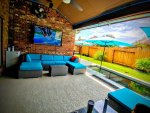So yes, a few things to clear-up ....
- Those numbers you read online are generic industry numbers posted across the board without regard to pool type, method of chlorination, and potential side effects.
- Are you using our
PoolMath APP yet? If not, you should. It's a great tool that tells you if you're water is within TFP ranges.
- TFP has uses science and years of pool evaluations to develop specific levels for each pool type. For example, salt pools require a higher CYA level. Tabs/pucks increase CYA over time that can disrupt proper chemistry. A lower TA can help prevent the pH from rising too fast. There are many more examples, but most of it starts with our
ABCs of Pool Water Chemistry and using the
PoolMath APP.
- As you may have heard already, we never trust pool store testing, and their CYA test is notorious for being incorrect. If you have the Taylor K-2006C test kit, that is all you need. See my CYA testing note below and let us know if we can help you on that.
- For a non-salt pool, liquid pool chlorine and/or regular bleach is your best long-term sanitizer. Keep the FC and CYA balanced as noted on the
FC/CYA Levels. As I said, with tablets CYA will grow too fast and too high, then the pool store will tell you to replace your water. But the liquid chlorine has no side effects. Tabs are also very acidic and will drive the pH down which is why you see "generic" recommendation for a higher TA to compensate. We cover all of that for you.
But feel free to post your own numbers at ANY time. We'll look them over, tell you what's best to use, show your why (in writing), and help you learn to take 100% control.





